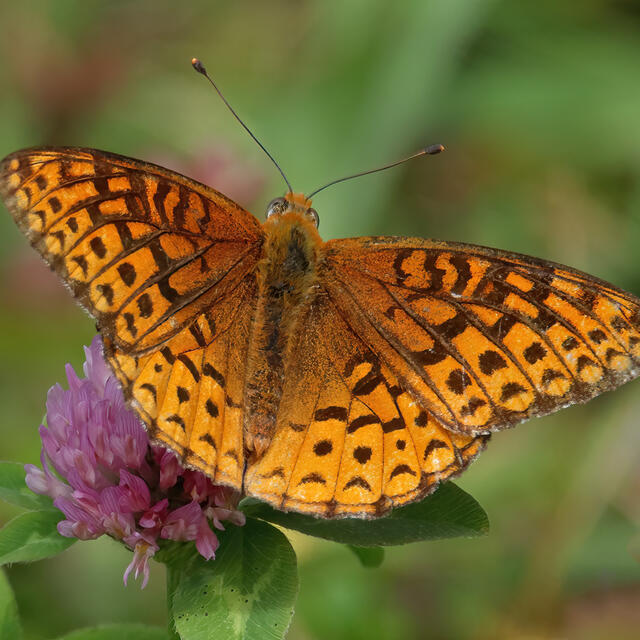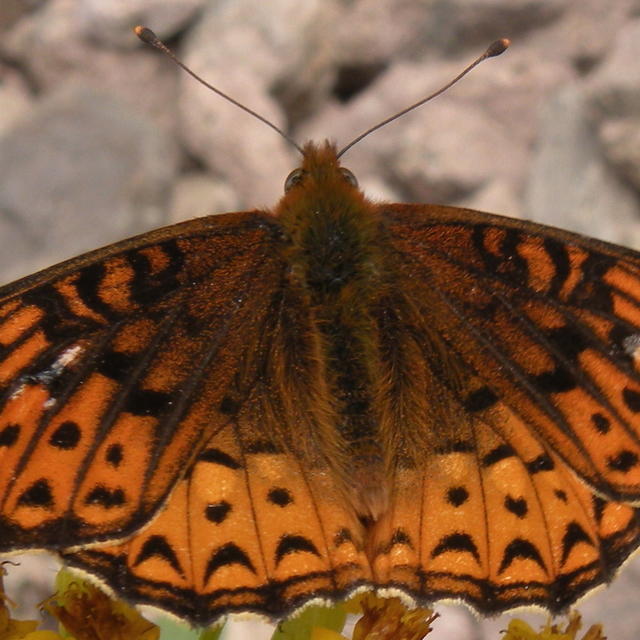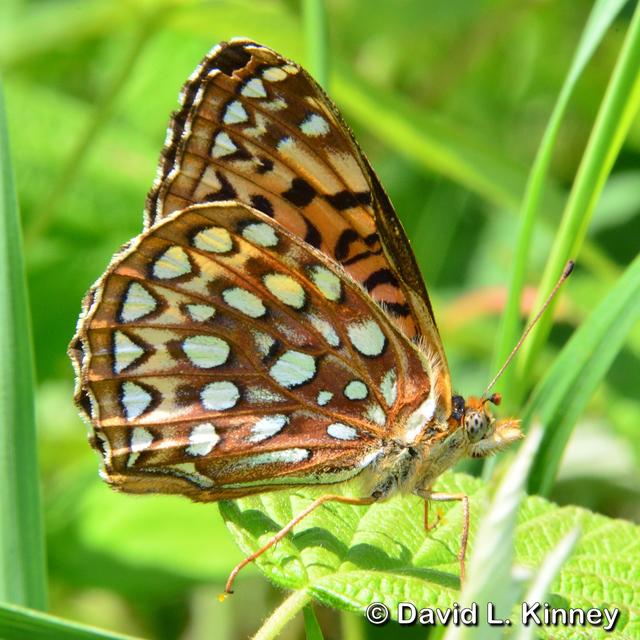Atlantis Fritillary
Speyeria atlantis (W.H. Edwards, 1862)
Family: Nymphalidae
Subfamily: Heliconiinae
Identification: Quite variable. Upperside orange-brown, darker at base, with black outer margins; male has black scales on veins. Underside of hindwing with basal disk chocolate brown or purplish, hindwing spots always silvered.
Wing Span: 2 - 2 3/4 inches (5 - 7 cm).
Life History: Males patrol during the day in forested areas or along streams. Eggs are laid singly on leaf litter near host plant. Unfed first-stage caterpillars overwinter, emerging in spring to feed on leaves.
Flight: One flight from mid-June to September.
Caterpillar Hosts: Violets.
Adult Food: Flower nectar including that from common milkweed, mints, mountain laurel, crown vetch, burdock, boneset, ox-eye daisy, spiraea, and virgin\'s bower.
Habitat: Forest openings, upland pastures, bogs, meadows, and moist canyons.
Range: Maritime Provinces and northeast United States south to West Virginia, west through the Great Lakes region and southern Canada. South in Rocky Mountains to Colorado Front Range.
Conservation: Not usually of conservation concern.
NCGR: G5 - Demonstrably secure globally, though it may be quite rare in parts of its range, especially at the periphery.
Management Needs: None reported.
Get your BAMONA Gear!
Please donate!
We depend on donations to keep Butterflies and Moths of North America freely available. We want to express our gratitude to all who showed their support by making a contribution this year. You can donate to support this project at any time.
Advertise with us!
Do you have a product or service that you think would interest BAMONA users? If you would like to advertise on this website, contact us by email, or use the contact form and select the "Advertising" category.
Verified Sightings
Displaying 1 - 24 of 1437 verified sightings

Observation date: Aug 30, 2010
Submitted by: Tom Dudones
Region: Franklin County, New York, United States
Verified by: jmgesell
Verified date: Oct 14, 2024

Observation date: Aug 23, 2024
Submitted by: Tom Dudones
Region: Franklin County, New York, United States
Verified by: jmgesell
Verified date: Aug 24, 2024

Observation date: Aug 23, 2024
Submitted by: Tom Dudones
Region: Franklin County, New York, United States
Verified by: jmgesell
Verified date: Aug 24, 2024

Observation date: Aug 23, 2024
Submitted by: Tom Dudones
Region: Franklin County, New York, United States
Verified by: jmgesell
Verified date: Aug 24, 2024

Observation date: Aug 05, 2024
Submitted by: Cyn6750
Region: New Brunswick, Canada
Verified by: jmgesell
Verified date: Aug 05, 2024

Observation date: Jul 02, 2024
Submitted by: Tom Dudones
Region: Essex County, New York, United States
Verified by: jmgesell
Verified date: Jul 05, 2024

Observation date: Jul 02, 2024
Submitted by: Tom Dudones
Region: Essex County, New York, United States
Verified by: jmgesell
Verified date: Jul 05, 2024

Observation date: Jul 04, 2024
Submitted by: Tom Dudones
Region: Essex County, New York, United States
Verified by: jmgesell
Verified date: Jul 05, 2024

Observation date: Jun 23, 2024
Submitted by: Bob Jacobson
Region: Chippewa County, Wisconsin, United States
Verified by: jmgesell
Verified date: Jul 02, 2024

Observation date: Jul 02, 2024
Submitted by: Tom Dudones
Region: Essex County, New York, United States
Verified by: jmgesell
Verified date: Jul 02, 2024

Observation date: Jun 26, 2024
Submitted by: Tom Dudones
Region: Franklin County, New York, United States
Verified by: jmgesell
Verified date: Jun 28, 2024

Observation date: Jun 12, 2024
Submitted by: tiki33wv
Region: Pocahontas County, West Virginia, United States
Verified by: curtis.lehman
Verified date: Jun 13, 2024

Observation date: Jul 18, 2018
Submitted by: tiki33wv
Region: Pocahontas County, West Virginia, United States
Verified by: curtis.lehman
Verified date: Apr 18, 2024

Observation date: Jul 01, 2023
Submitted by: terrymortier
Region: Douglas County, Wisconsin, United States
Verified by: jmgesell
Verified date: Mar 22, 2024

Observation date: Aug 17, 2023
Submitted by: Judith Huf
Region: Alberta, Canada
Verified by: Paul Prappas
Verified date: Sep 28, 2023

Observation date: Jul 22, 2023
Submitted by: ezeemonee
Region: Summit County, Colorado, United States
Verified by: mikefisher
Verified date: Sep 17, 2023

Observation date: Aug 23, 2023
Submitted by: Tom Dudones
Region: Franklin County, New York, United States
Verified by: jmgesell
Verified date: Aug 27, 2023

Observation date: Aug 06, 2023
Submitted by: k.d.stutzman
Region: Lewis County, New York, United States
Verified by: jmgesell
Verified date: Aug 16, 2023

Observation date: Aug 02, 2023
Submitted by: tjunderwood
Region: Berkshire County, Massachusetts, United States
Verified by: jwileyrains
Verified date: Aug 11, 2023

Observation date: Jul 27, 2023
Submitted by: John Gibbons
Region: Newfoundland and Labrador, Canada
Verified by: jmgesell
Verified date: Aug 09, 2023

Observation date: Jul 19, 2023
Submitted by: Tom Dudones
Region: Franklin County, New York, United States
Verified by: jmgesell
Verified date: Jul 22, 2023

Observation date: Jul 19, 2023
Submitted by: Tom Dudones
Region: Franklin County, New York, United States
Verified by: jmgesell
Verified date: Jul 22, 2023

Observation date: Jul 11, 2023
Submitted by: Tom Dudones
Region: Franklin County, New York, United States
Verified by: jmgesell
Verified date: Jul 14, 2023

Observation date: Jul 11, 2023
Submitted by: Tom Dudones
Region: Franklin County, New York, United States
Verified by: jmgesell
Verified date: Jul 14, 2023
- 1 of 60
- next ›








